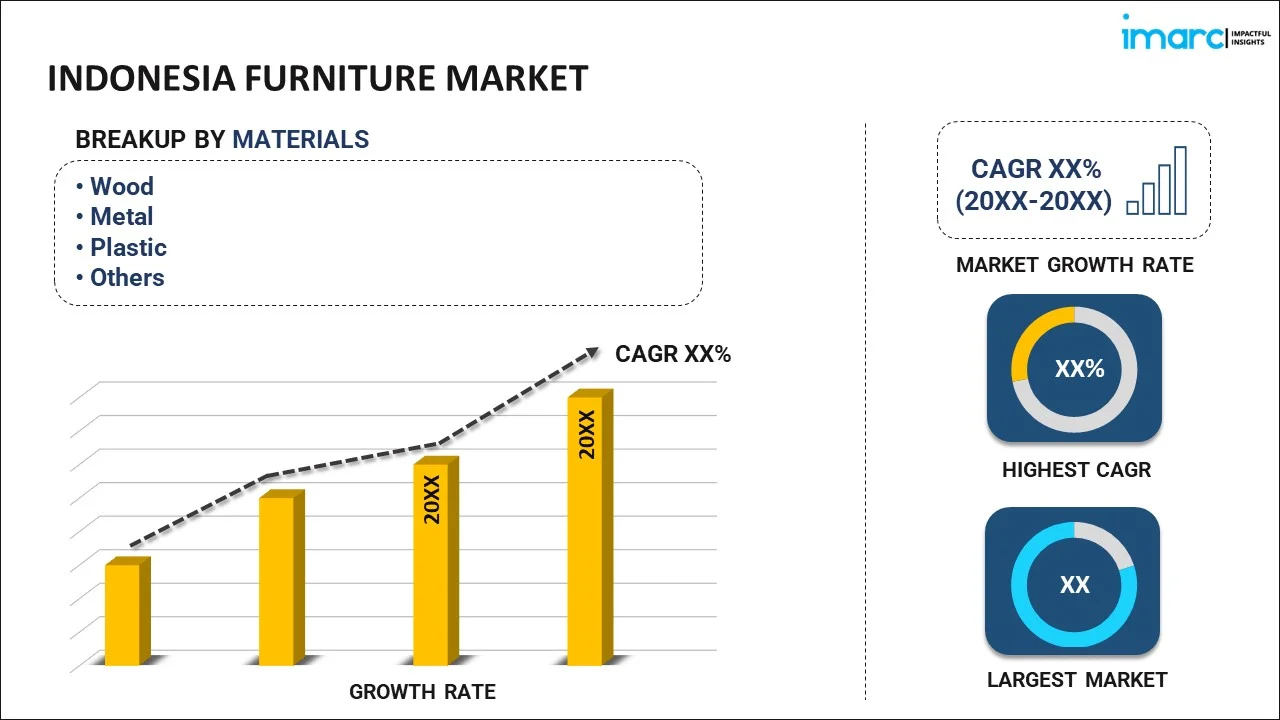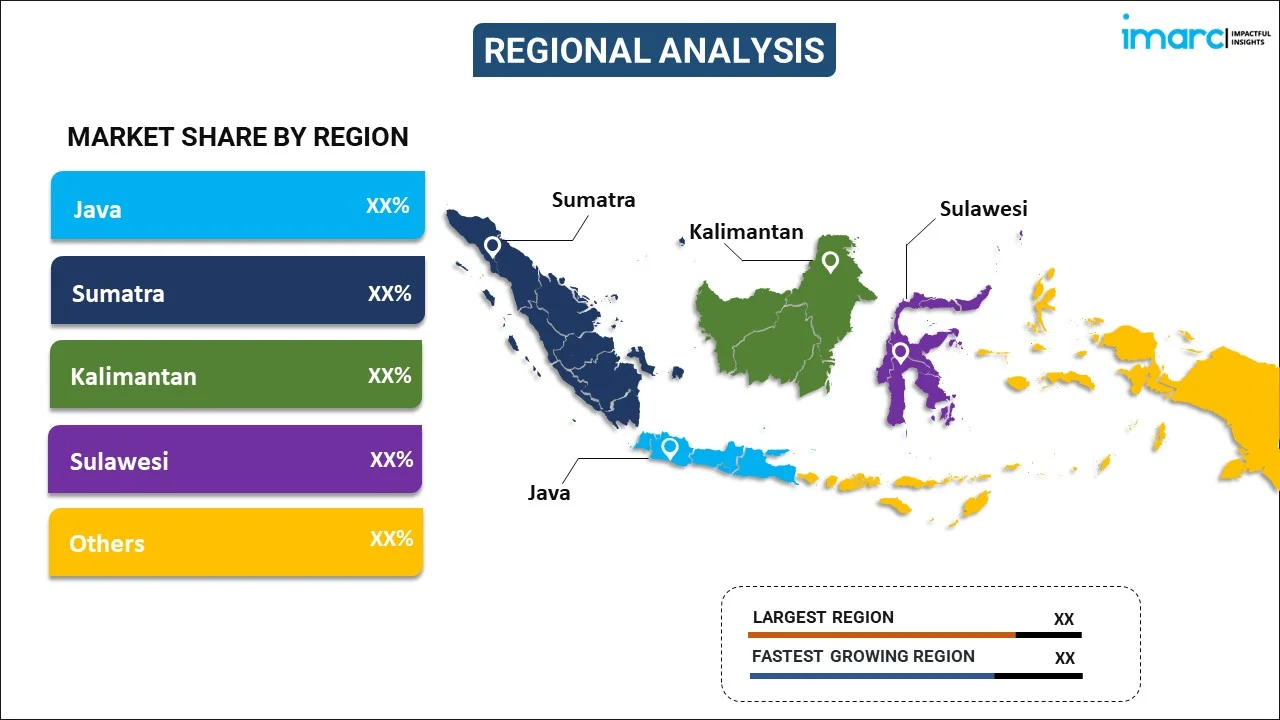
Indonesia Furniture Market Report by Material (Wood, Metal, Plastic, and Others), Application (Home Furniture, Office Furniture, Hospitality, and Others), Distribution Channel (Supermarkets, Specialty Stores, Online, and Others), and Region 2024-2032
Market Overview:
Indonesia furniture market size is projected to exhibit a growth rate (CAGR) of 6.39% during 2024-2032. The abundant availability of high-quality raw materials across the country, a rising middle-class population with inflating disposable incomes, the increasing number of housing projects, and the implementation of supportive government policies represent some of the key factors driving the market.
|
Report Attribute
|
Key Statistics
|
|---|---|
|
Base Year
|
2023 |
|
Forecast Years
|
2024-2032 |
|
Historical Years
|
2018-2023
|
| Market Growth Rate (2024-2032) | 6.39% |
Furniture refers to movable objects designed to support various human activities such as sitting, lying down, and storing items. The primary materials used in furniture making are wood, metal, plastics, and textiles, each offering unique characteristics like durability, aesthetics, and comfort. Furniture serves both functional and aesthetic purposes, complementing the architectural elements within a living or working space. Modern furniture design incorporates sustainability by utilizing eco-friendly materials and manufacturing processes. Moreover, the trend toward smart furniture is gaining momentum, with integrated technologies such as wireless charging, Bluetooth speakers, and automated adjustability offering enhanced user experience. Consequently, furniture represents an evolving aspect of human life that reflects cultural, technological, and social changes.
Indonesia Furniture Market Trends:
The Indonesia furniture market is experiencing robust growth, driven by several key factors that are shaping its landscape. One of the most prominent drivers is the abundant availability of raw materials, particularly teak and rattan, which are native to Indonesia's forests. This natural resource advantage gives the country a competitive edge in producing high-quality furniture. Additionally, the growing middle class in Indonesia is contributing to a higher demand for furniture. As disposable incomes grow, more consumers are spending on home improvement and interior decoration, fueling the market growth. Besides this, the emergence of various housing projects and the development of residential areas have augmented the demand for furniture items, both for indoor and outdoor use. Moreover, the Indonesian government is actively supporting the furniture industry through various incentives and policies. Export-oriented policies, coupled with reduced bureaucracy and streamlined logistics, are making it easier for local manufacturers to reach global markets. The country is also striving to become a global furniture hub, targeting export markets such as the United States, Europe, and other Asian countries, which is fostering market growth. Furthermore, technological advancements in manufacturing processes represent another major growth-inducing factor. Modern machinery and design software are optimizing production, reducing costs, and improving efficiency. This technological innovation is enabling Indonesian furniture companies to compete on a global scale in terms of quality and innovation, thereby propelling market growth. Along with this, the rapid proliferation of e-commerce across the country is further supporting market growth. Online platforms are eliminating geographical barriers and making it easier for consumers to access a wide range of products. The younger generation, who are digitally savvy, are increasingly adopting online shopping for furniture, which is accelerating product sales through digital channels. Besides this, the cultural richness of Indonesia, with its diverse art and crafts traditions, is becoming an integral part of furniture designs, attracting both domestic and international consumers looking for unique, artisanal pieces, thus catalyzing market growth.
Indonesia Furniture Market Segmentation:
IMARC Group provides an analysis of the key trends in each segment of the market, along with forecasts at the country level for 2024-2032. Our report has categorized the market based on material, application, and distribution channel.
Material Insights:

- Wood
- Metal
- Plastic
- Others
The report has provided a detailed breakup and analysis of the market based on the material. This includes wood, metal, plastic, and others.
Application Insights:
- Home Furniture
- Office Furniture
- Hospitality
- Others
A detailed breakup and analysis of the market based on the application have also been provided in the report. This includes home furniture, office furniture, hospitality, and others.
Distribution Channel Insights:
- Supermarkets
- Specialty Stores
- Online
- Others
The report has provided a detailed breakup and analysis of the market based on the distribution channel. This includes supermarkets, specialty stores, online, and others.
Regional Insights:

- Java
- Sumatra
- Kalimantan
- Sulawesi
- Others
The report has also provided a comprehensive analysis of all the major regional markets, which include Java, Sumatra, Kalimantan, Sulawesi, and Others.
Competitive Landscape:
The market research report has also provided a comprehensive analysis of the competitive landscape in the market. Competitive analysis such as market structure, key player positioning, top winning strategies, competitive dashboard, and company evaluation quadrant has been covered in the report. Also, detailed profiles of all major companies have been provided.
Indonesia Furniture Market Report Coverage:
| Report Features | Details |
|---|---|
| Base Year of the Analysis | 2023 |
| Historical Period | 2018-2023 |
| Forecast Period | 2024-2032 |
| Units | US$ Million |
| Scope of the Report | Exploration of Historical Trends and Market Outlook, Industry Catalysts and Challenges, Segment-Wise Historical and Future Market Assessment:
|
| Materials Covered | Wood, Metal, Plastic, Others |
| Applications Covered | Home Furniture, Office Furniture, Hospitality, Others |
| Distribution Channels Covered | Supermarkets, Specialty Stores, Online, Others |
| Regions Covered | Java, Sumatra, Kalimantan, Sulawesi, Others |
| Customization Scope | 10% Free Customization |
| Report Price and Purchase Option | Single User License: US$ 3699 Five User License: US$ 4699 Corporate License: US$ 5699 |
| Post-Sale Analyst Support | 10-12 Weeks |
| Delivery Format | PDF and Excel through Email (We can also provide the editable version of the report in PPT/Word format on special request) |
Key Questions Answered in This Report:
- How has the Indonesia furniture market performed so far and how will it perform in the coming years?
- What has been the impact of COVID-19 on the Indonesia furniture market?
- What is the breakup of the Indonesia furniture market on the basis of material?
- What is the breakup of the Indonesia furniture market on the basis of application?
- What is the breakup of the Indonesia furniture market on the basis of distribution channel?
- What are the various stages in the value chain of the Indonesia furniture market?
- What are the key driving factors and challenges in the Indonesia furniture?
- What is the structure of the Indonesia furniture market and who are the key players?
- What is the degree of competition in the Indonesia furniture market?
Key Benefits for Stakeholders:
- IMARC’s industry report offers a comprehensive quantitative analysis of various market segments, historical and current market trends, market forecasts, and dynamics of the Indonesia furniture market from 2018-2032.
- The research report provides the latest information on the market drivers, challenges, and opportunities in the Indonesia furniture market.
- Porter's five forces analysis assist stakeholders in assessing the impact of new entrants, competitive rivalry, supplier power, buyer power, and the threat of substitution. It helps stakeholders to analyze the level of competition within the Indonesia furniture industry and its attractiveness.
- Competitive landscape allows stakeholders to understand their competitive environment and provides an insight into the current positions of key players in the market.
Need more help?
- Speak to our experienced analysts for insights on the current market scenarios.
- Include additional segments and countries to customize the report as per your requirement.
- Gain an unparalleled competitive advantage in your domain by understanding how to utilize the report and positively impacting your operations and revenue.
- For further assistance, please connect with our analysts.
 Inquire Before Buying
Inquire Before Buying
 Speak to an Analyst
Speak to an Analyst
 Request Brochure
Request Brochure
 Request Customization
Request Customization




.webp)




.webp)












